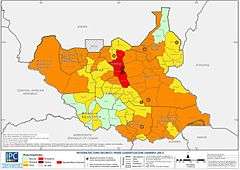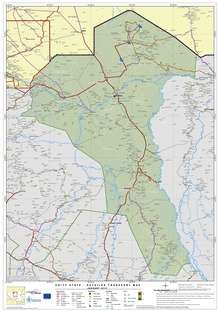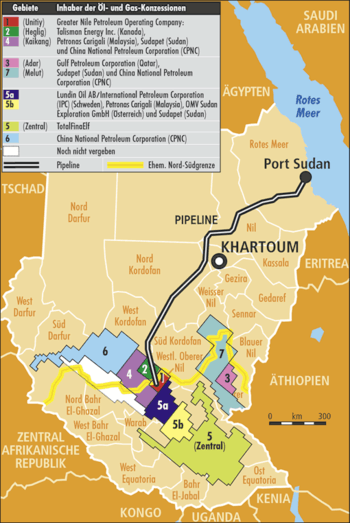2017 South Sudan famine
| 2017 South Sudan famine | |
|---|---|
 January 2017 map with phase classifications from "minimal" to "famine" | |
| Country | South Sudan |
| Period | February 2017 – June 2017 |
| Observations | War, drought |
In the early months of 2017, parts of South Sudan experienced a famine following several years of instability in the country's food supply caused by war and drought. The famine, largely focused in the northern part of the country, affected an estimated five million people (nearly 50% of the South Sudanese population). In May 2017, the famine was officially undeclared[1] but international humanitarian agencies warned of continued severe food insecurity[2].
Background


South Sudan suffered the 1998 Sudan famine before its independence, but no famine had been formally declared anywhere in the world during the six years prior to 2017. There are currently warnings of imminent famine in Yemen, Somalia, and the northeastern part of Nigeria, but the formal declaration requires that the following criteria be met:[3]
- 20% of households suffer extreme food shortages.
- 30% of the population suffers extreme malnutrition.
- At least 1 per each 5,000 inhabitants die per day.
A February 20 update of the Integrated Food Security Phase Classification (IPC) found that 4.9 million South Sudan residents, 40% of the population, were in need of "urgent food, agriculture, and nutrition assistance". The report had surveyed 23 counties, of which 14 exceeded the emergency action threshold of 15% acute malnutrition.[4] The World Food Programme carried out relief operations throughout the war, mitigating the risk of famine in other areas including the Northern Bahr el Ghazal state.[5] Bahr el Ghazal had been the region most severely affected in the 1998 famine, when it was struck by a two-year drought, a ban on humanitarian airdrops, restrictions on movement of displaced persons, confiscation of cattle and destruction of food stores.[6]
A 2016 UN report described the former Unity State as the site of continuous fighting throughout the civil war because it has "great economic and symbolic importance because of its vast oil resources and also as a predominantly Nuer state, in a conflict that has pitted the two dominant tribes, Dinkas and Nuers, against each other".[7][nb 1] Looting and burning in Unity State and displacement of its inhabitants in fighting over oil reserves also occurred in the Second Sudanese Civil War in the years leading up to the 1998 Sudan famine.[8] It is estimated that in 1998, 12,000 people starved in the Block 5A area out of 240,000 total, with another 160,000 forcibly displaced.[9] Instability is a major reason for the low oil production in South Sudan since 2012.[10]
Progression to famine
In February 2015 the World Food Programme noted the potential for drought in South Sudan and other nearby countries due to the developing El Niño event. Their report found that South Sudan was "experiencing a very good start to the agricultural season" and suggested it might be an exception to a pessimistic regional prediction for July to September 2015.[11]
In June 2015 the Famine Early Warning Systems Network observed a spike in food prices and an increase in the number of households likely to face catastrophic famine. These were attributable in part to economic considerations including increasing transport costs, a decrease in the parallel exchange rate of the South Sudanese Pound from 6.1 to 11.5 per United States Dollar, and the loss of government credit allowing import of food at the official exchange rate of 2.9 SSP per USD. At the time 8.8% of households surveyed in Ayod and 1.4% in Mayendit had a household hunger score of 5 or 6, which was below the 20% threshold for regional famine.[12][13]
By September 2015, Leer County, the home of rebel leader Riek Machar and future epicentre of the famine, had been rendered devoid of cattle and nearly empty of civilians fleeing massacre and the burning of homes and fields; drought contributed in part by lowering crop yields and in part by reducing the length of a traditional pause in fighting for the rainy season.[14]
In January 2016, a WHO report noted that "existing conditions may lead to famine" due to drought in the central and eastern part of the country.[15]
In March 2016, the UN reported that the South Sudan Army was being paid not in money but with a "do what you can and take what you can" policy that allowed them to confiscate cattle and other possessions, and even to rape and murder civilian women as a form of salary.[16] The report described all sides but especially the South Sudan government SPLA forces and allied militia making targeted attacks on civilians based on ethnicity, systematically destroying towns and villages.[7] It concluded that the pattern of abuses "suggests a deliberate strategy to deprive the civilians living in the area of any form of livelihood or material support."[17]
By August 2016, South Sudan was gripped by an "almost entirely man-made" food crisis attributed more to blockage of food assistance than to drought. At the time nearly 25% of the country's population was in a state of disparity. Sudan is in urgent need of food assistance.[18]
By June 2017, the food crisis had subsided and the UN considered the famine to be over, while still pointing out that 1.7 million people were facing the level of food insecurity just below famine.[19]
As of December 2017, there was an estimated 42% of the South Sudanese population facing severe security conditions, with most of the effected being young people and children. [20]
Effects
On 20 February 2017, the United Nations declared a famine in parts of former Unity State of South Sudan and warned that it could spread rapidly without further action. The World Food Programme reported that 40% of the South Sudanese population (4.9 million people) needed food urgently,[21][3] and at least 100,000, according to the UN, were in imminent danger of death by starvation.[22] UN officials said President Salva Kiir Mayardit was blocking food deliveries to some areas,[23] though Kiir said on 21 February that the government would allow "unimpeded access" to aid organizations.[24]
In addition, parts of South Sudan have not had rain in two years.[25] According to United Nations Food and Agriculture Organization Representative Serge Tissot, "Our worst fears have been realised. Many families have exhausted every means they have to survive. The people are predominantly farmers and war has disrupted agriculture. They’ve lost their livestock, even their farming tools. For months there has been a total reliance on whatever plants they can find and fish they can catch."[5]
The reports also warned that about 5.5 million people, half of South Sudan's population, are expected to suffer food shortages and insecurity by July 2017. According to Jeremy Hopkins, the South Sudan representative for the UN children's agency, more than 200,000 children are at risk of death from malnutrition in the country.[26]
Responses
Government of South Sudan
Days after the declaration of famine, the government raised the price of a business visa from $100 to $10,000, mostly aimed at aid workers, citing a need to increase government revenue.[27] U.N. officials said that President Salva Kiir Mayardit was blocking food deliveries to some areas.[28]
United Nations
In 2016 several UN agencies and other relief agencies intensified their efforts, setting a new record for post-independence South Sudan by reaching four million people with 265,000 metric tons of food assistance and $13.8 million in cash assistance.[5] According to the UN Children's Fund Deputy Executive Director and UN Assistant Secretary General Justin Forsyth, "Nobody should be dying of starvation in 2017. There is enough food in the world, we have enough capability in terms of the humanitarian community. In South Sudan, UNICEF has 620 feeding centres for severely malnourished children, so the places where children are dying are places we can't get to, or get to only occasionally. If there was access, we could save all of these children's lives."[29] Furthermore, UNICEF warned that more than 1 million children in South Sudan are subjected to malnutrition.[30]
European Union
On 21 February, the United Kingdom said that it would issue £100 million in aid to South Sudan in 2017, while the European Union said that it would send £69 million.[31]
See also
Notes
- ↑ An ethnic map of South Sudan by Mehrdad Izady may be viewed is available from Columbia University. Unity State can be recognized on this map as a region with Nuer and Dinka inhabitants west of the White Nile or Mountain Nile (Bahr al Jabal or Supiri River) but within the historical Greater Upper Nile province.
References
- ↑ "Integrated Food Security Phase Classification, The Republic of South Sudan" (PDF). Integrated Food Security Phase Classification. May 2017.
- ↑ "Hunger rising in South Sudan despite ebb in famine: UN agencies". UN News. 2017-06-21. Retrieved 2018-09-30.
- 1 2 "South Sudan declares famine in Unity State". BBC News. 20 February 2017.
- ↑ "Republic of South Sudan: Current and Projected (January–July 2017) Acute Food Insecurity Situation: 01/01/2017 – 31/07/2017: South Sudan". Integrated Food Security Phase Classification. 20 February 2017.
- 1 2 3 "Famine declared in parts of South Sudan". Sudan Tribune. 20 February 2017.
- ↑ "Bahr El Ghazal and the Famine of 1998". Human Rights Watch.
- 1 2 "Assessment mission by the Office of the United Nations High Commissioner for Human Rights to improve human rights, accountability, reconciliation and capacity in South Sudan: detailed findings". UN Office of the High Commissioner and the Secretary-General. 3 March 2016.
- ↑ "Sudan, Oil, and Human Rights". Human Rights Watch. September 2003.
- ↑ Lisa Abend (4 July 2010). "Was a Swedish Firm Complicit in Sudan's War?".
- ↑ James Burgess (26 May 2016). "War-Torn South Sudan To Resume Oil Production In July". Oilprice.com.
- ↑ "El Niño: Implications and Scenarios for 2015" (PDF). World Food Programme.
- ↑ "Famine watchdog warns some people 'likely' to starve in southern Unity State". Radio Tamazuj. 25 June 2015.
- ↑ "Some households face Catastrophe as food aid delivery remains blocked and prices spike". Famine Early Warning Systems Network. 24 June 2015.
- ↑ Alastair Leithead (28 September 2015). "South Sudan's men of dishonour". BBC.
- ↑ "El Niño and health: SOUTH SUDAN overview" (PDF). World Health Organization. January 2016.
- ↑ "South Sudan: Women raped 'as reward for fighters'". BBC. 11 March 2016.
- ↑ "South Sudan: UN report contains "searing" account of killings, rapes and destruction". United Nations Human Rights Office of the High Commissioner. 11 March 2016.
- ↑ "Drought and war spark famine across Horn of Africa and South Sudan". Deutsche Welle. 2 August 2016.
- ↑ "South Sudan no longer in famine". BBC News. Retrieved 21 Jun 2017.
- ↑ Parach Mach (4 April 2018). "Collateral Damage". D+C, development and cooperation. Retrieved 6 May 2018.
- ↑ "Famine Hits Parts Of South Sudan". World Food Programme. 20 February 2017.
- ↑ "In South Sudan, People Are Dying Of Hunger As Civil War Continues". NPR. 21 February 2017. Retrieved 22 February 2017.
- ↑ "Famine declared in part of South Sudan by government and UN". WHIO. 20 February 2017. Archived from the original on 2017-02-21. Retrieved 2017-02-20.
- ↑ "South Sudan promises 'unimpeded' aid access amid famine". The Washington Post. 21 February 2017. Retrieved 22 February 2017.
- ↑ "Famine gripping Somalia and South Sudan". ABC News. 20 February 2017.
- ↑ "Famine declared in part of South Sudan by government and UN". Johnson City Press. Retrieved 22 February 2017.
- ↑ "South Sudan hikes visa cost to $10,000 amid famine". Alaraby. 5 March 2017. Retrieved 6 March 2017.
- ↑ "Famine declared in part of South Sudan by government and UN". WHIO. 20 February 2017. Archived from the original on 2017-02-21. Retrieved 2017-02-20.
- ↑ "Why are there still famines?". BBC. 21 February 2017.
- ↑ CNN, Farai Sevenzo and Bryony Jones. "Famine declared in South Sudan". CNN. Retrieved 2017-03-07.
- ↑ "UK and EU pledge £170m in aid to combat famine in South Sudan". The Guardian. 22 February 2017. Retrieved 22 February 2017.